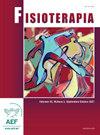职业羽毛球运动员常见的肘部伸展肌腱的肌肉毒性适应:一项观察性研究
Q4 Health Professions
引用次数: 0
摘要
高水平的运动练习可以在运动员的肌肉肌腱结构中产生组织适应性。在不对称的运动中,如羽毛球,这些适应可以在优势和非优势方面有所不同。本研究的目的是评估职业羽毛球运动员的总伸肌腱的结构和功能特征,并观察男女之间的差异。方法西班牙羽毛球国家队12名运动员,其中女性50%,年龄23岁,年龄5岁。通过超声评估和随后的图像分析来评估总伸肌腱的厚度和横截面积,以及桡侧短腕伸肌的面积。此外,还进行了回声性、新生血管和超声改变的定量分析。还评估了双侧手握力。结果分析显示优势侧肌腱厚度大于非优势侧(0.4±0.2 mm, P< 0.05)。超声特征分析显示新生血管和其他超声特征存在差异,但这些差异无统计学意义,除了优势侧的肌腱回声强度明显低于非优势侧(P< 0.05)。男女握力也存在差异(49.1±8.9 vs 35.9±9.4 kg;P<.05),但在形态学测量中没有发现显著差异。结论专业羽毛球训练可使运动员的总伸肌腱产生结构不对称,这可能是组织对所受负荷的适应。本文章由计算机程序翻译,如有差异,请以英文原文为准。
Adaptaciones musculotendinosas del tendón extensor común del codo en jugadores profesionales de bádminton: un estudio observacional
Introduction
High-level sports practice can generate tissue adaptations in the athlete's musculotendinous structures. In asymmetrical sports, such as badminton, these adaptations can vary between the dominant and non-dominant side. The aim of the study was to evaluate the structural and functional characteristics of the common extensor tendon in professional badminton players, as well as to see the difference between women and men.
Methods
Twelve players from the Spanish Badminton National Team (50% female, age: 23 years, SD: 5 years) participated. Ultrasound evaluation and subsequent image analysis were performed to assess the thickness and cross-sectional area of the common extensor tendon, as well as the area of extensor carpi radialis brevis muscle. Furthermore, a quantitative analysis of echogenicity, neovascularisation and ultrasound alterations was performed. Bilateral hand grip strength was also assessed.
Results
Analysis revealed greater tendon thickness on the dominant side compared to the non-dominant side (0.4 ± 0.2 mm, P<.05). Analysis of ultrasound characteristics showed differences in neovascularisation and other ultrasound characteristics, but these were not statistically significant, except for tendon echo-intensity which was significantly lower on the dominant side than on the non-dominant side (P<.05). There was also a difference in grip strength between males and females (49.1 ± 8.9 vs 35.9 ± 9.4 kg; P<.05), although no significant differences were found between them in morphological measurements.
Conclusions
It seems that professional badminton practice can generate structural asymmetries in the common extensor tendon of the athlete, which can be considered as tissue adaptations to the load received.
求助全文
通过发布文献求助,成功后即可免费获取论文全文。
去求助
来源期刊

Fisioterapia
Health Professions-Physical Therapy, Sports Therapy and Rehabilitation
CiteScore
0.50
自引率
0.00%
发文量
37
期刊介绍:
Publicación Oficial de la Sociedad Española de Fisioterapeutas. Sus páginas ofrecen desde artículos originales hasta revisiones, pasando por el estudio de casos o los actos más importantes relacionados con la especialidad.
 求助内容:
求助内容: 应助结果提醒方式:
应助结果提醒方式:


